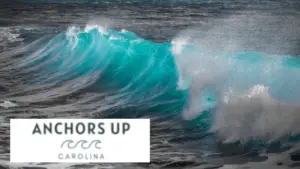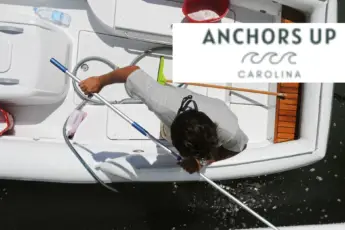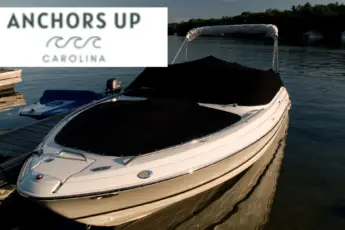Swells and waves are significantly different in how they affect boaters offshore and while venturing through inlets. I have been onboard vessels crossing wide open oceans and can tell you first hand the two are uniquely different. Importantly, steering a boat in swells versus waves must be approached differently. Each year, boat operators put themselves in dangerous situations when failing to recognize the impacts of a swell vs wave. Here is what you need to know about how a swell versus a wave impacts boaters.
Understand The Terminology For Measuring Waves And Swells
First, it is important to understand terminology in measuring either waves or swells. Here is a breakdown of how the two are measured.
Crest
The wave’s crest is the top of the wave at its highest point. The crest can either be rolling gently or breaking steeply.
Importantly, the crest of a wave, compared to a swell, is often more steep and rolls. The rolls are called white caps because of the frothy air bubbles they create.
Alternatively, the crest of a swell is gentle offshore. Swells do not break unless they are approaching the shoreline. A boater can expect a continuous up and down motion over long distances in swells.
Trough
Opposite of the crest is the trough. The trough is the lowest point of the wave or swell. I have been in deep troughs that block all vision around the boat because of the height of the surrounding swells.
Again, the trough is the same whether you are determining the lowest point of the wave or the swell. However, a deep trough means challenging navigating regarding waves compared to swells.
Height
The height of the wave is the measurement between the trough and the crest. The larger the distance, the bigger the wave or swell. Believe it or not, a wave measuring over 1,700 feet was recorded in 1958, striking Alaska.
Wave heights and swell heights result from wind strength, whether at a distance or within close proximity. I suggest reading a marine forecast before venturing offshore to determine wave and swell heights.
Wave Length or Period
Importantly, the wavelength or period is the measurement of the distance between the crests of waves or swells.
Wavelengths highly impact the ability of a boat operator to remain in control depending on if they are encountering a wave or swell. For the most part, the period is longer for a swell when compared to a wave. However, short wavelengths spell trouble and put boaters at risk.
What Is A Swell
As a mariner, I often enjoyed a swell offshore because swells are gentle rolling waves that travel long distances across the ocean. Conversely, they are not nearly as easy to manage when entering or exiting an inlet.
Importantly, a swell is the up and down motion of the sea generated by winds at a distance. A swell is often the result of a tropical disturbance far from land. The power of the wind can generate massive swells that travel hundreds of miles.
I have experienced a swell off the coast of Georgia from tropical disturbances moving through the area near the Equatorial Atlantic.
What Is A Wave
The opposite of a swell is a wave generated from wind within close proximity. A wave is formed as the result of current conditions. That said, the wind must be blowing in your vicinity for waves to be generated at sea.
A wave is different from a swell because they have a much shorter wavelength in comparison. Importantly, waves form on swells; it is not uncommon to have a wind chop on top of a rolling swell. However, a swell is not always present.
I can tell you from my experience that you will visibly see the difference between a wave and swell, especially as the wind speeds pick up. Understand that when the winds blow, waves will form.
How To Best Drive A Boat In Swells
Understanding how to drive a boat in a swell, no matter if you’re offshore or venturing through an inlet, is critical. Understand the methods for operating a boat in swells.
Navigating Inlets With A Swell
One of the most challenging and dangerous areas of navigation is inlets, especially when a swell is rolling. I have had close calls entering and exiting inlets when the swell heights are significant.
First, read the marine forecast before heading out of an inlet. In the event that you encounter dangerous swell heights, stay home. It’s not worth taking a chance.
Typically, swells come in sets of three, so it is imperative to count off the swells before proceeding. A breaking swell over the boat’s bow is deadly, similar to the risk of capsizing. Trust me, those gentle rolling waves at sea will break as they near the shoreline. Don’t fall victim to catapulting backward or swamping your vessel.
Importantly, position the boat before the break and count the swells. Most often, you can quickly power through after the third in the set has broken, but that’s not always the case. A hesitation in proceeding further increases the risk. It should be noted that swells are amplified when the tide flows out compared to inland. The opposition further increases the height.
When heading back in, use the same method. Count the swells to ensure they do not break over the stern and swamp the vessel. Power through the swell when the time is right.
Navigation Offshore Waters With A Swell
First, if you made it out of the inlet and into the open water, then the risk is greatly minimized. Offshore, you will encounter a gentle rolling swell with a long wavelength.
Honestly, your biggest risk is you or the passengers becoming sick from the constant up and down of the vessel as it passes through the crests and troughs.
How To Best Drive A Boat In Waves
As the operator, waves present a unique set of challenges depending on the height and the wavelength. What to know about safely driving a boat in waves.
Navigating Inlets With Waves
Like swells, an operator must drive similarly when exiting or entering an inlet in waves.
Importantly, you won’t notice sets compared to a swell; instead, it will be a steady onslaught of rough seas.
Remember, an outgoing tide has the same impact on waves driven by wind in the opposite direction. For this reason, extra caution must be taken when departing or arriving on the outgoing.
Again, check the marine forecast. If it calls for conditions greater than you or your boat can handle, don’t take the risk. Also, don’t lay off on the throttle or turn around, as the boat is prone to capsizing. It should be noted when I say power up, that doesn’t mean full throttle but instead a speed to keep the bow up to prevent waves from breaking over the bow.
Lastly, when returning, monitor the bow and stern. Watch for waves breaking aft and avoid stuffing the bow when surfing down a wave. Without question, you will have to throttle up and down when maneuvering the waves.

Navigating Offshore Waters With Waves
Navigating offshore in waves is challenging, depending on the size of the boat and the size of the wave.
Unfortunately, boats capsize year after year because the operator is pushing the limits. When you see white caps in the distance, I suggest staying home at the dock. In addition to not being safe, the ride will be unpleasant, to say the least. Lastly, wind-driven waves will cause seaspray soaking you and your passengers.
One of the most important aspects of operating a boat in large waves is approaching the wave at a 45-degree angle. The angle reduces the likelihood of capsizing.
Unquestionably, a small wind-driven wave in the 1-3 foot range is suitable for most vessels ranging between 18 and 25 feet. Once you push 4 feet plus, that changes the ability to maneuver.
A Swells Vs Wave Impacts Boaters In A Much Different Way
Without question, a boater must resort to different techniques when driving a boat in swells vs wave. I have had to operate in both, in addition to a combination of swells and waves. The key is to remain safe by not pushing the limits. Stay back home if it’s more than you and the boat can handle. Another day to get on the water is on the horizon.






